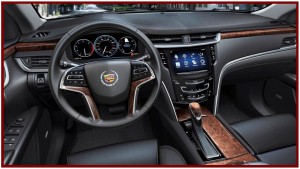
Cadillac XTS appears in the U.S. dealerships later this spring starting at $44,995, including destination.
Cadillac will build the new XTS luxury sedan in China in conjunction with its mandated joint-venture partner Shanghai General Motors (SGM) starting this fall. Cadillac sold a record 30,000 vehicles in China in 2011, compared with 17,000 in 2010 even with punitive Chinese tariffs that are designed to force local production.
XTS would not be the first Cadillac assembled in China, though. The SLS Executive Sedan, an extended-length luxury car sold only in China that began production in 2006. The new 2013 Cadillac XTS launches in North America later this spring with production beginning in the coming weeks at the Oshawa, Ontario Assembly Plant.
“It is projected that by the end of the decade half of all luxury purchases in the world – all categories, not just cars – will occur in China,” said Don Butler, Cadillac vice president of marketing.
Cadillac also said it would sell the ELR – a CTS coupe with the Chevrolet Volt hybrid powertrain adapted to it – in China sometime in the future.

CUE, or Cadillac User Experience, is comprised of the eight-inch screen in the “center stack,” the faceplate below the screen and steering wheel controls. The center stack has only seven buttons – four of them for the radio. That’s less than half the controls found on the center stack of the typical car.
XTS is larger than the current CTS line, but at 202 inches in overall length, much smaller than historic Cadillac sedans, the 5-passenger car lacks a V8 and uses a 300 horsepower (224 kW) direct injectionV6 coupled to an all-wheel-drive system. A front-wheel-drive version will also be available.
Cadillac XTS will be the most-spacious Cadillac sedan in the revised line, with interior space roughly comparable to current full-size sedans. In what appears to be a clear bid to make the XTS saleable to the chauffeur-driven communist ruling class in China, XTS has 40 inches (1,016 mm) of rear legroom. That is about four more inches than the BMW 5 Series, and Mercedes-Benz E-Class and about two more inches than the Audi A6 – and comparable to larger sedans.
The Germans, of course, sell stretched versions of their cars in China to provide the required rear space. Ultimately, Cadillac needs a bigger car then XTS if it is serious about competing globally in the luxury car market, especially in China.
GM previously said that it would invest $117 million to prepare the Oshawa Assembly Plant in Canada to build the XTS, creating, or in the current lamentable employment trend “retaining” 400 jobs on a flexible production line. The full-size Chevrolet Impala is also built at Oshawa now and eventually will share a version of the platform with Cadillac this fall.
First shown as the Cadillac XTS Platinum concept car in 2010 at the NAIAS in Detroit, the concept was a V6 powered, all-wheel-drive plug-in hybrid design. No word on a hybrid today.
XTS is a so-called “five meter” car, as was the Cadillac Catera, about the size of just cancelled STS or just over 200 inches in overall length, once considered the optimum size for a European luxury car before BMW and Mercedes upped the ante with super-sized S-class and 7-series behemoths.
Cadillac has apparently abandoned plans for a new generation of rear-wheel-drive cars, and the XTS is derived from the evolving GM Epsilon front-drive platform. To some, XTS appears a cautious or bland design that is derived from the Cadillac 16 concept with its styling forms adapted to the different proportions.
The semi-big sedan will be without a V8 engine, using instead a smallish V6, a nod to the inevitable demise of the V8 engine, which for six decades defined American automotive excellence, but now in a world of encroaching CO2 limits and increasingly stringent fuel economy regulations would look more like decadence.

